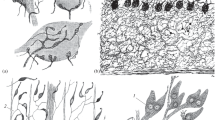Summary
“Synaptic” ribbons (SR), functionally enigmatic structures of mammalian pinealocytes, were studied electron microscopically with regard to number, intracellular localization and topographical relationships, both under normal and experimental conditions. Pineal glands of guinea-pigs serving as controls contained 1.75 ribbon fields/unit area in the males and 2.58 in the females. In animals subjected to continuous illumination for 64 days the number of ribbon fields increased 20-fold in the males and 9-fold in the females. Continuous darkness (26 to 70 days) had varying effects; in some animals SR increased either strongly or moderately, in others they appeared unchanged. Under continuous illumination a higher percentage of ribbon fields bordered the cell membrane than in the controls. Moreover, paired ribbon fields occurred. The topographical analysis revealed that 98 % of the ribbon fields bordering the cell membrane lay opposite another pinealocyte and the remainder opposite nerve fibres, blood vessels and collagenous fibres. It is suggested that SR of mammalian pinealocytes do not represent non-functioning phylogenetic relics but true organelles possibly involved in coupling adjacent pinealocytes functionally.
Zusammenfassung
In der vorliegenden Studie wurden die funktionell unklaren “synaptic ribbons” (SR) der Säugerzirbeldrüse hinsichtlich Zahl, intrazellulärer Lokalisation und topographischer Beziehungen unter normalen und experimentellen Bedingungen untersucht. In der Zirbeldrüse von Meerschweinchen, die als Kontrollen dienten, wurden bei Männchen 1,75 und bei Weibchen 2,58 Ribbonfelder/Flächeneinheit gefunden. Nach 64tägigem Aufenthalt der Tiere in ständiger Helligkeit zeigten die Männchen eine 20-, die Weibchen eine 9fache Zunahme dieser Strukturen. Nach Aufenthalt in ständiger Dunkelheit (26–70 Tage) waren die Resultate uneinheitlich: einige Tiere zeigten eine starke bzw. mäßige, andere keine Zunahme der SR. Nach Dauerbelichtung fand sich ein höherer Prozentsatz von Ribbonfeldern in unmittelbarer Nachbarschaft der Zellmembran als bei Kontrollen. Außderdem kam es zum Auftreten von paarigen Ribbonfeldern. 98 % der an Zellmembranen angrenzenden Ribbonfelder lagen benachbarten Pinealocyten, der Rest Nerven, Blutgefäßen und Bindegewebe gegenüber. Es wird angenommen, daß die SR der Säugerzirbeldrüse keine funktionslosen phylogenetischen Relikte darstellen, sondern echte Zellorganellen sind, die möglicherweise benachbarte Pinealzellen funktionell koppeln.
Similar content being viewed by others
References
Arstila, A. U., Kalimo, H. O., Hyyppä, M.: Secretory organelles of the rat pineal gland: electron microscopic and histochemical studies in vivo and in vitro. In: The pineal gland (G. E. W. Wolstenholme and J. Knight, eds.) p. 147–164. Edinburgh-London: Churchill Livingstone 1971.
Bargmann, W.: Histologie und mikroskopische Anatomie des Menschen. 6. Aufl. Stuttgart: Thieme 1967.
Bayrhuber, H.: Über die Synapsenformen und das Vorkommen von Acetylcholinesterase in der Epiphyse von Bombina variegata (L.), (Anura). Z. Zellforsch. 126, 278–296 (1972).
Bunt, A. H.: Enzymatic digestion of synaptic ribbons in amphibian retinal photoreceptors. Brain Res. 25, 571–577 (1971).
Collin, J.-P.: Differentiation and regression of the cells of the sensory line in the epiphysis cerebri. In: The pineal gland (G. E. W. Wolstenholme and J. Knight, eds.) p. 79–120. Edinburgh-London: Churchill Livingstone 1971.
Dowling, J. E., Boycott, B. B.: Organization of the primate retina: electron microscopy. Proc. roy. Soc. B 116, 80–111 (1966).
Gray, E. G., Pease, H. L.: On understanding the organization of the retinal receptor synapses. Brain Res. 35, 1–15 (1971).
Hopsu, V. K., Arstila, A. U.: An apparent somato-somatic synaptic structure in the pineal gland of the rat. Exp. Cell Res. 37, 484–487 (1965).
Kappers, J. A.: The development, topographical relations and innervation of the epiphysis cerebri in the albino rat. Z. Zellforsch. 52, 163–215 (1960).
Kappers, J. A.: The mammalian pineal organ. J. neur.-visc. Rel., Suppl. 9, 140–184 (1969).
Kappers, J. A.: The pineal organ: an introduction. In: The pineal gland (G. E. W. Wolstenholme and J. Knight, eds.) p. 3–25. Edinburgh-London: Churchill Livingstone 1971a.
Kappers, J. A.: Discussion remark. In: The pineal gland (G. E. W. Wolstenholme and J. Knight, eds.) p. 121. Edinburgh-London: Churchill Livingstone 1971b.
Loewenstein, W. R.: Permeability of membrane junctions. Ann. N.Y. Acad. Sc. 137, 441–472 (1966).
Lues, G.: Die Feinstruktur der Zirbeldrüse normaler, trächtiger und experimentell beeinflußter Meerschweinchen. Z. Zellforsch. 114, 38–60 (1971).
Oksche, A.: Sensory and glandular elements of the pineal organ. In: The pineal gland (G. E. W. Wolstenholme and J. Knight, eds.), p. 127–146. Edinburgh-London: Churchill Livingstone 1971.
Pfanzagl, J.: Allgemeine Methodenlehre der Statistik II, 3. Aufl. Berlin: de Gruyter & Co. 1968.
Sjöstrand, F. S.: Ultrastructure of retinal rod synapses of the guinea-pig eye as revealed by three dimensional reconstructions from serial sections. J. Ultrastruct. Res. 2, 122–170 (1958).
Smith, C. A., Sjöstrand, F. S.: A synaptic structure in the hair cells of the guinea-pig cochlea. J. Ultrastruct. Res. 5, 184–192 (1961).
Szabo, T., Wersäll, J.: Ultrastructure of an electroreceptor (Mormyromast) in a mormyroid fish, Gnathonemus petersii II. J. Ultrastruct. Res. 30, 473–490 (1970).
Szamier, R. B., Wachtel, A. W.: Special cutaneous receptor organs of fish. VI. Ampullary and tuberous organs of Hypopomus. J. Ultrastruct. Res. 30, 450–471 (1970).
Vollrath, L., Schmidt, D. S.: Enzymhistochemische Untersuchungen an der Zirbeldrüse normaler und trächtiger Meerschweinchen. Histochemie 20, 328–337 (1969).
Wartenberg, H.: The mammalian pineal organ: electron microscopic studies on the fine structure of pinealocytes, glial cells and on the perivascular compartment. Z. Zellforsch. 86, 74–97 (1968).
Wersäll, J., Flock, Å., Lundquist, P. G.: Structural basis for directional sensitivity in cochlear and vestibular sensory receptors. Cold Spr. Harb. Symp. quant. Biol. 30, 115–132 (1965).
Wolfe, D. E.: The epiphyseal cell: an electron-microscopic study of its intercellular relationships and intracellular morphology in the pineal body of the albino rat. Progr. Brain Res. 10, 332–386 (1965).
Wurtman, R. J., Anton-Tay, F.: The mammalian pineal as a neuroendocrine transducer. Recent Progr. Horm. Res. 25, 493–522 (1969).
Wurtman, R. J., Axelrod, J., Kelly, D. E.: The pineal. New York-London: Academic Press 1968.
Author information
Authors and Affiliations
Additional information
This study was supported by a grant from the Deutsche Forschungsgemeinschaft, Bonn.
Rights and permissions
About this article
Cite this article
Vollrath, L., Huss, H. The synaptic ribbons of the guinea-pig pineal gland under normal and experimental conditions. Z.Zellforsch 139, 417–429 (1973). https://doi.org/10.1007/BF00306595
Received:
Issue Date:
DOI: https://doi.org/10.1007/BF00306595




